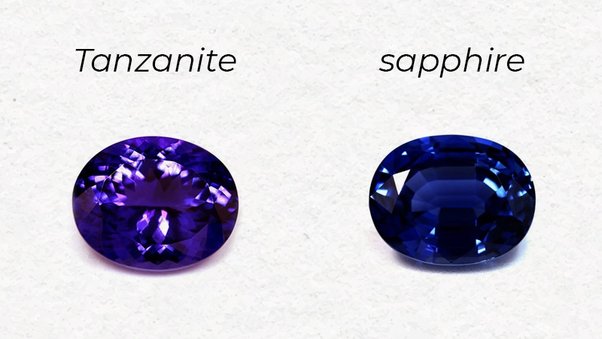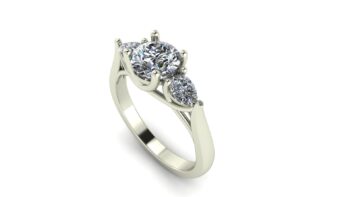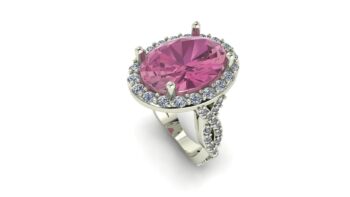Sapphire Vs Tanzanite
It can be hard to tell the difference between Sapphire Vs Tanzanite with only a short glance. There are a lot of similarities and certain specimens can look like the same species. However, they are very different gemstones, especially physically. In this post, we will discuss the two stones and their properties. We will go over their differences, similarities, as well as pros and cons. Whether you are an aspiring gemologist or just wanting a piece of jewelry with a blue stone in it. You will be much more informed after reading this.
What Is A Sapphire?
Sapphires are gemstones that are known for their stunning blue color. They are a variety of the mineral corundum and are one of the hardest gemstones, second only to diamonds. In addition to their beautiful color, sapphires also have excellent durability, making them ideal for jewelry that can withstand daily wear and tear. Their physical properties include a high refractive index, which gives them a brilliant sparkle, and a strong resistance to scratches and abrasions. In my opinion, sapphires are not only visually appealing, but also a practical choice for those looking for a gemstone that will stand the test of time.
One interesting physical property of sapphires is their pleochroism, which means that they can exhibit different colors when viewed from different angles. This phenomenon adds depth and complexity to the gemstone’s appearance, making it even more captivating. Another notable characteristic of sapphires is their high density, which contributes to their substantial weight and solid feel. This weightiness is often associated with luxury and quality, enhancing the overall appeal of sapphire jewelry.
Furthermore, sapphires are also valued for their rarity. While blue sapphires are the most well-known and sought-after, they can actually come in a variety of colors, including pink, yellow, and even colorless. Each color variation has its own unique charm and can cater to different personal preferences. As a result, sapphires offer a wide range of options for those looking to add a touch of elegance and individuality to their jewelry collection.
What Is A Tanzanite?
Tanzanite is a rare and exquisite gemstone that is highly valued for its stunning blue-violet hue. It was discovered in Tanzania in the 1960s and has since gained popularity among gemstone enthusiasts worldwide. One of its unique physical properties is its pleochroism, which means it can exhibit different colors when viewed from different angles. This adds to its allure and makes it a truly captivating gemstone.
In addition to its mesmerizing color, tanzanite also has a remarkable hardness. It ranks 6.5 to 7 on the Mohs scale, making it suitable for everyday wear. However, it is important to note that tanzanite is relatively brittle, so it should be handled with care to avoid any damage.
Another interesting physical property of tanzanite is its trichroic nature. When light passes through the gemstone, it splits into three different colors – blue, violet, and burgundy. This creates a dazzling display of colors that is truly a feast for the eyes.
Sapphire Vs Tanzanite – The Differences
Sapphire and Tanzanite are both stunning gemstones, but they have some key differences. First off, let’s talk about their colors. Sapphire comes in a range of hues, from deep blue to pink, yellow, and even green. Tanzanite, on the other hand, is known for its mesmerizing blue-violet shade. It’s a unique and eye-catching color that sets it apart from other gemstones.
Another difference between these two gemstones is their rarity. Sapphire is relatively common and can be found in various parts of the world, including Australia, and Madagascar. Tanzanite, however, is much rarer and can only be found in one place – Tanzania. This exclusivity adds to its allure and makes it a prized gemstone among collectors.
In terms of hardness, sapphire is one of the hardest gemstones, ranking 9 on the Mohs scale. This means it’s highly durable and can withstand everyday wear and tear. Tanzanite, on the other hand, is a bit softer, ranking 6.5-7 on the Mohs scale. While it’s still a relatively durable gemstone, it requires a bit more care to prevent scratches and damage.
Tanzanite Trichroism
Tanzanite is a gemstone known for its unique trichroism. Trichroism refers to the ability of a gemstone to exhibit three different colors when viewed from different angles. In the case of tanzanite, these colors are typically blue, violet, and burgundy. This mesmerizing phenomenon is what makes tanzanite truly stand out among other gemstones.
Personally, we find tanzanite’s trichroism absolutely captivating. It’s like having three gemstones in one! Depending on how you look at it, tanzanite can appear as a stunning deep blue, a rich violet, or a luscious burgundy. This versatility makes it a favorite among jewelry enthusiasts who appreciate its ever-changing beauty.
What’s even more fascinating is the scientific explanation behind tanzanite’s trichroism. It is caused by the presence of different impurities and structural defects within the crystal lattice. These imperfections interact with light in such a way that it gets absorbed and reflected differently, resulting in the three distinct colors. It’s like a magical dance of photons within the gemstone!
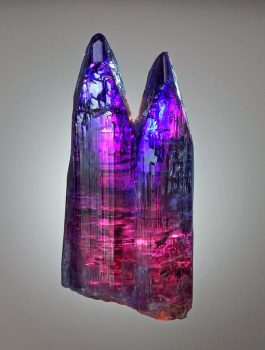
Clarity & Crystal Structure In Sapphire Vs Tanzanite
When it comes to clarity, Sapphire and Tanzanite are quite different gemstones. Sapphire is known for its exceptional clarity, with few to no visible inclusions. On the other hand, Tanzanite tends to have more visible inclusions, which can affect its overall clarity. While some people may appreciate the unique character that inclusions bring to Tanzanite, others may prefer the pristine clarity of Sapphire. Ultimately, it comes down to personal preference and what you value in a gemstone. So, if you’re looking for a gemstone with impeccable clarity, Sapphire is the way to go. However, if you’re drawn to the allure of inclusions and the distinctive beauty they bring, Tanzanite might be the perfect choice for you.
Tanzanite and sapphire have distinct crystal structures. Tanzanite belongs to the orthorhombic crystal system, while sapphire belongs to the hexagonal crystal system. This means that tanzanite crystals have three unequal axes, while sapphire crystals have three equal axes and one axis perpendicular to the others. Personally, I find the unique crystal structure of tanzanite quite fascinating, as it adds to its allure and charm. However, the classic and symmetrical crystal structure of sapphire also has its own appeal. Ultimately, the choice between the two comes down to personal preference and the desired aesthetic.
Fluorescence
Tanzanite and sapphire are two popular gemstones known for their stunning colors and brilliance. One key difference between them is their fluorescence. Tanzanite exhibits a strong blue-violet fluorescence under ultraviolet light, giving it a unique glow. On the other hand, sapphire generally does not fluoresce or only shows a weak fluorescence. This distinction adds an extra touch of allure to tanzanite, making it stand out among other gemstones.
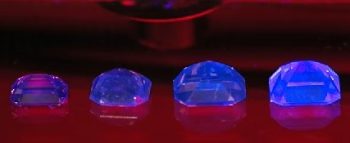
Sapphire Vs Tanzanite – The Similarities
Sapphire Vs Tanzanite may seem similar at first glance, but they have distinct differences that set them apart. Both gemstones are known for their stunning blue hues, but sapphires are typically deeper and richer in color, while tanzanites have a more vibrant and purplish-blue shade. In terms of hardness, sapphires are one of the hardest gemstones, ranking just below diamonds, whereas tanzanites are relatively softer and more susceptible to scratches. When it comes to rarity, tanzanites are considered rarer than sapphires, as they can only be found in one location in Tanzania. In conclusion, while both gemstones are beautiful in their own right, sapphires offer a timeless elegance and durability, while tanzanites provide a unique and vibrant alternative for those looking for something more distinctive.
Sapphire Vs Tanzanite – Price
When it comes to comparing the prices of Sapphire Vs Tanzanite, there are a few key factors to consider. Tanzanite, a rare gemstone found only in Tanzania, is known for its vibrant blue-violet color. Sapphire, on the other hand, comes in a variety of colors, with blue being the most popular. In terms of price, tanzanite tends to be more expensive than sapphire due to its rarity and limited supply. However, it’s important to note that the price of both gemstones can vary depending on factors such as size, quality, and market demand. Ultimately, the choice between tanzanite and sapphire will depend on your personal preference and budget. So, whether you’re looking for a unique and luxurious option or a classic and versatile choice, both tanzanite and sapphire have their own appeal.
Sapphire Vs Tanzanite – How To Visually Tell The Difference
The easiest way to tell the difference between Sapphire Vs Tanzanite is to scratch them with a drill bit. Sapphire is far harder than most stones and will resist scratching. Tanzanite, will scratch. However, this method is not a good one if you have two polished stones.
The second most reliable method is incandescent light vs fluorescent light. If you place a tanzanite under fluorescent light, the stone shows a blue color. However, if you view it under incandescent light, it will show a more violet color. Regular sapphires will not do this. There are color change sapphires that will, but they are not common.
Looking for a Sapphire Or Tanzanite Ring?
We make custom jewelry to order. That means we will find the perfect sapphire or tanzanite for your custom jewelry creation. Unlike the chain jewelry stores, we pick each stone for each project. That means you will get to choose from any stone available. In the chain stores, you are limited to what is in stock. So, why buy a mas produced ring that 1000’s can have when we can create something matching your personality and style? And many times, custom jewelry can cost less than something comparable at eh chain stores.
You can view our portfolio of custom engagement rings or custom pendants to look for ideas. Or you can contact us with your own idea.
